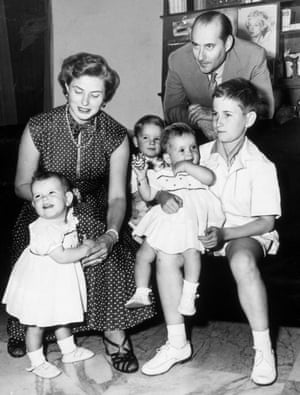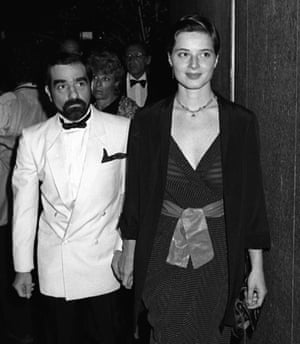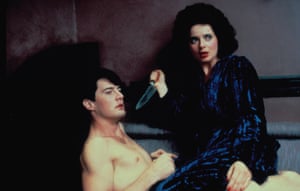 |
| Isabelle Rosellini Photo by Richard Avedon |
Isabella Rossellini: ‘There is no work between 45 and 60 – you’re in limbo’
At 43, Isabella Rossellini was sacked as the face of Lancôme. Now, 20 years on, she’s been rehired. She talks movies, her mother, Ingrid Bergman, and her rollercoaster life
Sali Hughes
Saturday 9 July 2016 09.00 BST
I
n 1996, when Isabella Rossellini was about to turn 44, she was sacked. After 14 years as the face and spokesperson of Lancôme cosmetics, she was told in no uncertain terms that she was past it. Beauty advertising was about the dream, executives told her, not the harsh reality, and women dreamed about being young; the actor’s face would soon become an unwelcome reminder of the ageing process. And so, despite Rossellini’s insistence that eternal youth was neither her dream nor that of any woman she knew (she says she told Lancôme that the new dream was to be independent, to be powerful, to assert yourself ), she was replaced, rather humiliatingly, by the very similar-looking Juliette Binoche – dark hair, pale skin, full lips, high cheekbones – only 12 years her junior. Heartbroken at the prospect of losing her job, her main source of income and a second family of colleagues, the mother of two asked a senior executive what she was supposed to do next. He said, Rossellini recalls, “I am not your wet nurse.”
“It was pretty rough, no doubt, it was hard,” she says now, as we sit in a grand, flower-filled room at the scene of the crime, Lancôme’s HQ in Paris, where, at 64, Isabella Rossellini is all smiles and once again the star attraction. “My daughter was 10 and my son was one, and I was a single mum. I cried and was depressed, and I worried financially.” As a fortysomething single mother of two myself, I tell her I can well imagine. What I’m struggling to understand is how, when Lancôme called her just eight months ago to ask her to return to the fold, Rossellini didn’t suggest they shove their mascara up their derriere and twist it.
She is unfathomably magnanimous. “There was that feeling, when a friend asked why I was going back,” she concedes. “I said, ‘Because I’m flattered, I’m very touched, I miss them.’ It’s very personal, but I don’t know whether I’m being forgiving.” Rossellini says the company from which she was ejected is now very different. “When I was here 20 years ago, the secretaries were women and the bosses were men. The industry was one of men creating products on the understanding that makeup was for seduction,” she says. “But I put makeup on even if I go out with my sister – there is a pleasure in the gesture. I was not understood.”
Significantly, the brand’s CEO is now a woman, Françoise Lehmann, and it was she who made the recent call. Having launched campaigns fronted by Penélope Cruz and Lupita Nyong’o, she felt it was high time Lancôme celebrated older age, too. As Rossellini explains, “ Last year, Lancôme turned 80, and we were thinking, what was life like for women 80 years ago? They couldn’t vote or own their own apartment – it’s incredible. We wanted to reflect the emancipation of women that has been so strong in our century.”
Having been born into scandal, Rossellini had seen her own mother fall foul of sexism and double standards. Ingrid Bergman met the director Roberto Rossellini on the set of Stromboli, fell in love and gave birth to his son while still married to her Swedish husband, Petter Lindstrom – the father of Isabella’s eldest sister, Pia. Despite a career as an Oscar and Tony award-winning actor, and perhaps because of her image as a modest, graceful embodiment of womanhood (Bergman had just played Joan Of Arc), her success was eclipsed by her adultery. In March 1950, in the wake of the affair and her subsequent marriage to Rossellini, Bergman was denounced on the floor of US Congress by Senator Edwin C Johnson as “a horrible example of womanhood and a powerful influence for evil”; she was, he said, an argument that actors should undergo background checks before being employed to entertain Americans. Despite Johnson’s belief that “out of Ingrid Bergman’s ashes will grow a better Hollywood”, the proposed bill proved unsuccessful, but the controversy damaged her career and family life. Bergman temporarily lost custody of Pia and retreated to the more forgiving European film industry. She and Rossellini later divorced, sharing joint custody of their children, Roberto Junior, four-year-old Isabella and her non-identical twin sister Ingrid (an academic who teaches Italian literature).
Bergman remarried, but Rossellini’s childhood remained complicated. She and her siblings lived between New York, Paris and Rome, staying in hotels and apartments with a nanny, her parents and step-parents taking it in turns to drop in and spend time with their seven collective children, who were understandably close (Rossellini’s trademark chipped tooth came when her 12-year-old brother threw a telephone at her face. Bergman cried for three days, but Isabella decided to keep it).
Before reaching her teens, Rossellini spent six months bedridden and two years in a body cast to correct scoliosis, or curvature of the spine. She had no intention of following her mother into the film industry. “I come from a generation of women where, though my mother was a famous actress and had a big career, we always assumed in the family that she was gifted with an enormous talent – so she was an exception, a freak. The other women in the family might work, they might not work – but, most of all, you are a good mother and you marry.”
She was, however, determined to be financially independent from a young age. Her father, scornful of money and commercialism, had died with just $200 in his bank account, while Bergman had entrusted her own financial affairs to accountants and been repeatedly burnt. “My mother never ran her money. It was intimidating for that generation. Women [in my family] always gave it to the men to take care of. I did say to my mum that I was going to take control of my own money. I had seen what happened if you don’t.”
At 25, while working as a television reporter, Rossellini was sent to interviewMartin Scorsese, who was promoting his film New York, New York. They hit it off, began dating and got married. The resulting exposure led to modelling offers, and very soon Rossellini was working with photographers such as Richard Avedon and Bruce Weber, and appearing on the cover of Vogue, (much, she has said, to Scorsese’s annoyance).
Despite this relatively late start in modelling (“I didn’t know models were 14,” Rossellini once said), Lancôme’s contract made her the highest-paid model in the world when it came in 1982. In an ironic case of history repeating itself, the contract contained a “morality clause” (much like the contracts of the 1950s Hollywood studio system); this was soon somewhat scuppered when Rossellini became pregnant by a modelling colleague while separated from, though still technically married to, Scorsese. Later, she would appear as a drag king in Madonna’s 1992 Sex book, to the consternation of Lancôme, who worried that people would think she was gay.
Given the pious morality imposed on her and her mother, I wonder if Rossellini ever reflects on how much we’ve progressed. “I have a feeling that it’s got worse,” she says. “My parents paid a very big price, but they were unique. Nowadays, there’s paparazzi everywhere. It’s also the organised celebrity thing – the red carpet has become a job. Sometimes we see the actors, and we know their names, but not necessarily the films they were in. It’s not very appealing to me, because I don’t like to do red carpets. It’s like a beauty competition, and I think everyone feels uncomfortable about it. A lot of actors are very shy people. There are a few who like public attention, but they’re a minority; I think actors like to act, and they like storytelling.”
Rossellini has often said she prefers modelling to acting, which downplays her considerable talents. She tells me modelling “gave me the confidence to act. Both my parents were very famous, so I was hesitant, but modelling gave me the feeling that I could dare.” Her iconic performance in Blue Velvet, as the bereft mother and lounge singer enduring horrific abuse at the hands of Dennis Hopper’s Frank Booth, won her an Independent Spirit award in 1986. Director David Lynchoriginally wanted Helen Mirren for the role, but Rossellini persuaded him to give her a chance; the pair went on to become a couple for six years.
Wild At Heart, her next project with Lynch, won the 1990 Palme d’Or at Cannes and, ironically, just a year before leaving Lancôme she’d starred in the critically acclaimed camp-fest Death Becomes Her, in which Rossellini’s character sells the secret of eternal youth to desperate ageing housewives in Hollywood. I wonder if, given that role, and the sacking from Lancôme soon afterwards, she herself became insecure about her advancing years?
Rossellini cheerfully insists she made a clear distinction between her professional and personal life: “When you’re young, there is so much pressure, because you work, you need money. As you grow older, the focus becomes clearer and clearer, if you like. Nobody ever talks about that, how wonderful it is to grow older. They always talk about wrinkles, but ageing is interesting, wrinkles or no wrinkles.”
Despite implicit pressures within the film and beauty industries, she has resisted plastic surgery (as someone with an acute radar for even discreet work, I’d stake my reputation on her appearance being entirely without intervention from either needle or knife). In 2012, Rossellini took part in the documentary About Face: Supermodels Then And Now, and said, “Sometimes I wake up and think, ‘Is this the new technology? Let’s go and do the operation.’ But most of the time I wake up and think, ‘Is this the new feet binding, is this the new way of being misogynist, is this a new way to tell women they’re ugly, is this a new way of telling women they should be this and this?’ And you give standards that are impossible to be reached, because the underlying problem is misogyny.”
he is, she tells me, not interested in chasing perfection. “When people tell me, ‘You look so glamorous, you look sophisticated or elegant,’ it’s wonderful. But when people say, ‘You’re beautiful,’ I find it a little condescending. Worse now, because they say, ‘You’re still beautiful.’ In Italian, we say it’s a knife with both edges, because I know that they mean it to please me, but it’s almost like saying to a black woman, ‘You’re not so dark, you don’t look so black.’ I am old: this is what 65 looks like.” She is irritated that her generation isn’t better catered for. “There is no fashion for women my age, I’m sorry to say.” She tugs at her lovely navy silk tunic. “This, I designed myself, because it’s impossible to find things that aren’t for just one type. It has to be skinny, or it has to be sexy – I don’t know what’s going on in fashion.” I point out that sleeves are as easy to find as black orchids. “Exactly! There are no sleeves. I want sleeves! You can’t find them.”
I wonder if it isn’t old age that Lancôme and Hollywood couldn’t deal with, but middle age. Geena Davis, Michelle Pfeiffer and Holly Hunter, all big stars in the 1990s, struggled to get good jobs in their 50s. Rossellini agrees: “My mum told me that there is no job for women between 45 and 60, because you are in-between. You are not young enough to play the young girl, but you are also not old enough to play the matriarch, the witch or grandmother. So there is a period of 15 years where you’re in limbo and they don’t know how to hire you. Then after 60, a lot of work comes back. That was true for my mum. And you see, Maggie Smith is the hottest thing on Earth. Helen Mirren is the hottest thing on Earth. Then there is this gap.”
Rossellini fell right into it. The film roles thinned out and, while hardly in the wilderness post-Lancôme, she was forced to create her own opportunities. She launched a short-lived but very good cosmetics line, Manifesto, for women of all ages and skin colours. She wrote and performed monologues, made a documentary about her mother, performed in plays off-Broadway and took on fun projects like a cameo in Friends, as Ross’s dream woman. She bought a small organic farm, studied animal behaviour and conservation, and trained guide dogs, though she recently had to stop after some lead tugging caused her to fall and injure her back.
“Guide dogs are labradors and golden retrievers,” she explains. “I could have broken my back, so I thought, no more training big dogs! So what I do now is whelp and it’s delightful.” Like a dog doula? “Exactly. They send me pregnant mamas, they have the puppies, then I keep them for two months and distribute them to all the volunteers for guide dog training.”
She had been happily retired from showbusiness for a year when she was offered a part in Joy, the romantic comedy starring Jennifer Lawrence and Robert De Niro, best friend of Scorsese, with whom Rossellini has remained close. She stopped cashing her actor’s trade union pension cheques, rejoined the workforce and, in the wake of Joy’s popularity, was offered a judging gig on upcoming reality TV show Master Of Photography and a role in a drama.
She still manages the farm. “All the people at the farm wondered where I was, because I was travelling again. For the moment, I try to manage it all, so we’ll see how long it lasts, this burst of work,” she says, taking nothing for granted. But she loves TV, and thinks it more attractive a proposition for mature women – actors and viewers alike. “The theory I have is that the films making the most money are made for young males, and that’s why they are these big action films. Not because mature women don’t like them, but because we have a family to raise and so we work, we are mothers, we cook, we are the caregivers – and we have careers. So at night after dinner, we can’t go out and watch films.” She feels television streaming on Netflix, Amazon and online boxed sets has opened up new and far more inclusive possibilities. “I think there will be a lot of actresses working again,” she smiles. “I’m doing a series called Shut Eye, and first of all I never expected to be the lead in something again. I’m a lead with other actors, but I am a very, very substantial part. There’s a whole new audience of mature people who can watch 45 minutes of television and then fall asleep. So it’s very fragmented. We don’t have these big event series where you have the entire country watching, but you have enough people to create many series, tell many stories.”
I wonder if Rossellini’s story, as the model, pastured middle-aged woman and then back again, is one she wishes she didn’t have to tell, or so generously forgive. She smiles. “I feel that it’s a story and this is the last chapter. It’s a happy ending.”







No comments:
Post a Comment